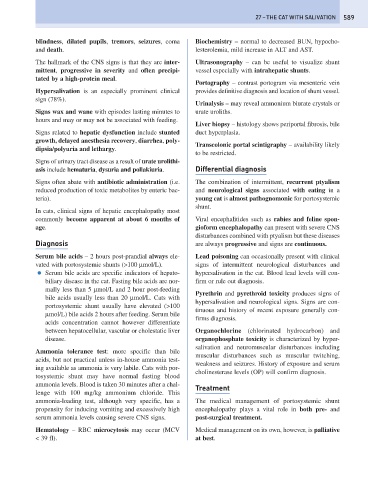Page 597 - Problem-Based Feline Medicine
P. 597
27 – THE CAT WITH SALIVATION 589
blindness, dilated pupils, tremors, seizures, coma Biochemistry – normal to decreased BUN, hypocho-
and death. lesterolemia, mild increase in ALT and AST.
The hallmark of the CNS signs is that they are inter- Ultrasonography – can be useful to visualize shunt
mittent, progressive in severity and often precipi- vessel especially with intrahepatic shunts.
tated by a high-protein meal.
Portography – contrast portogram via mesenteric vein
Hypersalivation is an especially prominent clinical provides definitive diagnosis and location of shunt vessel.
sign (78%).
Urinalysis – may reveal ammonium biurate crystals or
Signs wax and wane with episodes lasting minutes to urate uroliths.
hours and may or may not be associated with feeding.
Liver biopsy – histology shows periportal fibrosis, bile
Signs related to hepatic dysfunction include stunted duct hyperplasia.
growth, delayed anesthesia recovery, diarrhea, poly-
Transcolonic portal scintigraphy – availability likely
dipsia/polyuria and lethargy.
to be restricted.
Signs of urinary tract disease as a result of urate urolithi-
asis include hematuria, dysuria and pollakiuria. Differential diagnosis
Signs often abate with antibiotic administration (i.e. The combination of intermittent, recurrent ptyalism
reduced production of toxic metabolites by enteric bac- and neurological signs associated with eating in a
teria). young cat is almost pathognomonic for portosystemic
shunt.
In cats, clinical signs of hepatic encephalopathy most
commonly become apparent at about 6 months of Viral encephalitides such as rabies and feline spon-
age. gioform encephalopathy can present with severe CNS
disturbances combined with ptyalism but these diseases
Diagnosis are always progressive and signs are continuous.
Serum bile acids – 2 hours post-prandial always ele- Lead poisoning can occasionally present with clinical
vated with portosystemic shunts (>100 μmol/L). signs of intermittent neurological disturbances and
● Serum bile acids are specific indicators of hepato- hypersalivation in the cat. Blood lead levels will con-
biliary disease in the cat. Fasting bile acids are nor- firm or rule out diagnosis.
mally less than 5 μmol/L and 2 hour post-feeding
Pyrethrin and pyrethroid toxicity produces signs of
bile acids usually less than 20 μmol/L. Cats with
hypersalivation and neurological signs. Signs are con-
portosystemic shunt usually have elevated (>100
tinuous and history of recent exposure generally con-
μmol/L) bile acids 2 hours after feeding. Serum bile
firms diagnosis.
acids concentration cannot however differentiate
between hepatocellular, vascular or cholestatic liver Organochlorine (chlorinated hydrocarbon) and
disease. organophosphate toxicity is characterized by hyper-
salivation and neuromuscular disturbances including
Ammonia tolerance test: more specific than bile
muscular disturbances such as muscular twitching,
acids, but not practical unless in-house ammonia test-
weakness and seizures. History of exposure and serum
ing available as ammonia is very labile. Cats with por-
cholinesterase levels (OP) will confirm diagnosis.
tosystemic shunt may have normal fasting blood
ammonia levels. Blood is taken 30 minutes after a chal-
Treatment
lenge with 100 mg/kg ammonium chloride. This
ammonia-loading test, although very specific, has a The medical management of portosystemic shunt
propensity for inducing vomiting and excessively high encephalopathy plays a vital role in both pre- and
serum ammonia levels causing severe CNS signs. post-surgical treatment.
Hematology – RBC microcytosis may occur (MCV Medical management on its own, however, is palliative
< 39 fl). at best.

